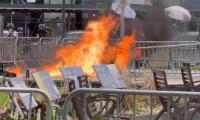SEOUL/WASHINGTON: Shutting down North Korea´s nuclear test site is trickier than it might seem. A botched tunnel collapse could spread radioactive debris. Nuclear material might be buried, but accessible enough to be dug up and reused in a weapon. And even if all the testing tunnels are destroyed, North Korean engineers could simply dig a new one if they want to conduct another nuclear test.
Disarmament experts have raised many such scenarios after North Korea said over the weekend that it would use explosives to collapse the tunnels of its Punggye-ri nuclear test site next week.
Pyongyang has publicly invited international media to witness the destruction, but not technical inspectors, leaving disarmament experts and nuclear scientists wondering how effective the plan is – and whether it will be safe.
Recent reports indicate that some areas of the Punggye-ri test site have become unstable after the latest and largest nuclear test in September. More explosions would be unnecessarily risky, but there are steps North Korea could take to make the shutdown more credible and safe, said Suh Kune-yull, professor of nuclear energy systems engineering at Seoul National University.
“Blowing up isn´t the most ideal way,” Suh said. “It might be less dramatic than an explosion, but filling the tunnel up with concrete, or sand or gravel would be best. “There is still a considerable amount of radiation being detected at one of the tunnel complexes where most of North Korea´s nuclear tests have taken place, including the latest test of what North Korea said was a fusion bomb, he said.
But underground nuclear test tunnels and shafts are typically designed to be sealed by the nuclear bomb´s blast wave before radioactive material can escape.Some experts noted that North Korea over the course of its six nuclear tests probably learned how to prevent radiation leaks.
Former US president Donald Trump. — AFP NEW YORK: The judge overseeing former US president Donald Trump’s...
Bosnian Serb leader Milorad Dodik. — AFP FileSARAJEVO: The parliament of Bosnia´s autonomous Serb Republic adopted...
Australia's Prime Minister Anthony Albanese speaks during the opening ceremony of the 6th China International Import...
Indonesia's Ruang volcano. — AFP JAKARTA: Indonesia shut a provincial airport and evacuated hundreds of people...
Myanmar’s detained former leader and Aung San Suu Kyi. — AFP LONDON: Myanmar’s detained former leader and Aung...
President Ruto is seen with the chief of the Kenya Defence Forces General Francis Ogolla in this photo on 28 February....







